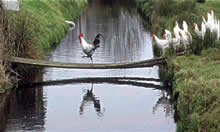Most of the LUC program's core (internally-funded) projects fall under the umbrella project
Agriculture in the 21th Century
IIASA’s integrated modelling framework comprises a global spatial agro-ecological zone (AEZ) model
and a regionalized general equilibrium model of the world food economy.
The two models form the basis of scenario evaluation and policy analysis of food and agriculture
in the 21st century at the national, regional and global levels.
The study includes analyses related to future demographic and economic development pathways
and of the potential impacts of climate change on, for example,
natural resources and the environment,
agricultural science and technology research priorities,
food and agricultural systems,
population and demographic changes and consumption,
international agricultural trade reforms and globalization,
and assessment of the scale and location of risks of hunger and malnutrition. More.
The following core-funded projects and activities are separate:
- Global assessment of bio-energy potentials
- Agro-ecological assessment for the transition of the agricultural sector in Ukraine
- Agro-ecological zones assessments for organic farming
- Livestock production and environmental risks
- Land use and catastrophes
- Robust expansion of agricultural production
- Integrated nitrogen management
- Economic instruments for environmental security
Global assessment of bio-energy potentials
This activity comprises a spatially detailed global estimation of agro-bio-energy potentials and, building on this spatially detailed understanding of agro-bio-energy sources, an assessment of development options, synergies, and land use competition among food and bio-energy plants.
Agro-ecological zones assessment for the transition of the agricultural sector in Ukraine
This activity aims to gain a better understanding of land use change and its effects on the transition of the agricultural sector of Ukraine, estimate the agricultural potential of Ukraine’s natural resources, and assess the impacts of climate change on crop suitability and yields in Ukraine. More.
Organic farming: Agro-ecological zonation
Conventional farming, in many instances, is causing concern about environmental degradation
of land, pollution of water resources, and in some cases, may cause health hazards for farmers.
LUC has started to explore possibilities for developing AEZ procedures to quantify the production potential
and environmental benefits of organic farming and precision farming. More.
Land use and catastrophes
This project conducts conceptual and model-based analysis to identify robust land use strategies and financial
measures for reducing impacts of natural catastrophes earthquakes, floods, storms) under climate change and variability,
with the objective to stabilize regional economic growth and to foster sustainable development. More.
Robust expansion of agricultural production
The goal of this project is to develop innovative methodologically sound approaches and modeling tools that would enable to analyze and design robust technical and financial measures to reduce pollution and emissions of greenhouse gases (GHGs) coming from agriculture. More
Economic instruments for environmental security
Economic instruments have gained particular attention as an important tool for implementing climate change abatement strategies, for environmental management and legislation, for enhancing of water and food security, insurance against man-made and natural catastrophes. The advantage of economic instruments is that they may encompass the provision of incentives for behavioural changes, the generation of revenue for financing environmental investments, the promotion of technological innovation, and the reduction of pollution at least cost to society as a whole. Having a number of advantages, implementation of economic instruments requires thorough investigation of all circumstances and conditions under which economic instruments work in a cost-efficient and environmentally safe way. More
Responsible for this page:
Elisabeth Kawczynski
Last updated:
30 Jan 2012
![]()


 Schlossplatz 1
Schlossplatz 1